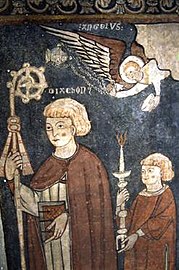Top Qs
Timeline
Chat
Perspective
January 21 (Eastern Orthodox liturgics)
Day in the Eastern Orthodox liturgical calendar From Wikipedia, the free encyclopedia
Remove ads
January 20 - Eastern Orthodox liturgical calendar - January 22

All fixed commemorations below are observed on February 3 by Eastern Orthodox Churches on the Old Calendar.[note 1]
For January 21st, Orthodox Churches on the Old Calendar commemorate the Saints listed on January 8.
Saints
- Martyrs Eugenios, Candidus, Valerianus, and Aquilas, at Trebizond (303)[1][2][3][4]
- Virgin-martyr Agnes of Rome (ca. 304)[1][3][5][6][note 2]
- Martyr Neophytus of Nicaea (305)[1][3][8][9]
- The Holy Four Martyrs of Tyre, by the sword.[10]
- Venerable Apollonios of the Thebaid, ascetic (4th century)[11] (see also: March 31)
- Venerable Maximus the Confessor (662)[1][3][12][13]
- Martyr Anastasius (662), disciple of St. Maximus the Confessor.[1][14][15]
- Saint Zosimas, Bishop of Syracuse (662)[1][3][16] (see also: March 30)
- Martyrs Gabriel and Zionios, and companions, under the Bulgarian ruler Omurtag (ca. 814-831)[17]
Remove ads
Pre-Schism Western saints
- Saint Publius, first Bishop of Malta and later Bishop of Athens, martyred under Trajan (ca. 112,[18] or, ca. 161-180[19])[18][note 3] (see also: March 13 in the East)
- Saint Fructuosus, Bishop of Tarragoña in Spain, and Deacons Augurius and Eulogius (259)[7][18][20][note 4]
- Martyr Patroclus of Troyes, under Aurelian (ca. 270-275)[3][7][18][21][note 5]
- Saint Epiphanius of Pavia, Bishop of Pavia (496)[7][18]
- Saint Brigid (Briga), known as St Brigid of Kilbride, venerated around Lismore in Ireland (6th century)[18]
- Saint Lawdog (6th century)[18][note 6]
- Saint Vimin (Wynnin, Gwynnin), a Bishop in Scotland, said to have founded the monastery of Holywood (6th century)[18]
- Saint Meinrad of Einsiedeln, hermit, martyred by robbers (861)[7][18][note 7]
- Saint Maccallin (Macallan), Abbot of Saint-Michel-en-Thiérache Abbey and Waulsort (978)[18][note 8]
Remove ads
Post-Schism Orthodox saints
- Saint Neophytus of Vatopedi monastery, Mt. Athos (14th century)[3][23][24](see also: January 20).
- Venerable Maximus the Greek of Russia (1556)[1][3][25][26][27]
- Venerable Timon, monk (desert-dweller) of Nadeyev and Kostroma (1840)[1][28][29]
- Saint George-John (Mkheidze) of Georgia (1960)[30][note 9]
New martyrs and confessors
Other commemorations
- Synaxis of All the Martyred Saints, from Protomartyr Stephen up to the present.[3][33][note 10][note 11]
- Synaxis of the Church of Holy Peace (Saint Irene), by the Sea in Constantinople.[1][34]
Icons
- "Paramythia" Icon of the Most Holy Theotokos (Vatopedi Mother of Consolation, Mother of God of Vatopedi), at Vatopedi monastery, Mt. Athos (807)[1][26][29][35][36]
- Icon of the Mother of God "Stabbed" (Greek: "Esphagmeni." Slavonic: "Zaklannaya"), at Vatopedi monastery (14th century)[29][37]
- Icon of the Mother of God "Xenophon Hodigitria" (1730)[29][38]
Remove ads
Icon gallery
- Panagia Paramythia Icon from Vatopedi Monastery 14th Century
- Aquila, Valerian, Eugene and Candidus of Trebizond (Menologion of Basil II)
- St. Agnes of Rome with a white lamb and a crucifix.
- Venerable Maximus the Confessor.
- Detail of a Romanesque mural of Saint Fructuosus.
- Venerable Maximus the Greek of Russia.
Notes
- The notation Old Style or (OS) is sometimes used to indicate a date in the Julian Calendar (which is used by churches on the "Old Calendar").
The notation New Style or (NS), indicates a date in the Revised Julian calendar (which is used by churches on the "New Calendar"). - "AT Rome, the passion of St. Agnes, virgin, who under Symphronius, governor of the city, was thrown into the fire, but as it was extinguished by her prayers, she was struck with the sword. Of her, St. Jerome writes: "Agnes is praised in the writings and by the tongues of all nations, especially in the churches. She overcame the weakness of her age, conquered the cruelty of the tyrant, and consecrated her chastity by martyrdom."[7]
- Fructuosus, Bishop of Tarragoña in Spain, and his two deacons, Augurius and Eulogius, were burnt at the stake under Valerian. When the fire had burnt through their bonds, they stretched out their arms in the form of a cross and died.
- "In South Wales, the festival of ST. LAWDOG, to whom are dedicated several churches in the diocese of ST. DAVID'S, and whose memory is marked on this day in an ancient Welsh Calendar."[22] Four churches are dedicated to him near St David's in Wales.
- Of the noble family of Hohenzollern, he became a monk at the monastery of Reichenau on the Rhine in Germany. Later he became a hermit in Switzerland, and this later became the monastery of Einsiedeln, meaning in German 'the Hermitage'. He lived as a hermit for twenty-five years, was murdered by robbers and is venerated as a martyr.
- Born in Ireland, he went to St Fursey's shrine in Péronne in France and entered the monastery of Gorze. Later he became a hermit and then Abbot of St Michael's monastery at Thiérache and Waulsort near Dinant in Belgium.
- See September 21 for Archimandrite John (Basil Maisuradze) († 1957).[31]
- This commemoration is celebrated today according to the Typikon of the Patriarchate of Jerusalem. The Synaxis takes place at the Church of Saint Stephen in Jerusalem, which was founded by Empress Aelia Eudocia circa 460 AD, wife of Theodosius II.
- (in Greek) "Πάντων των αγίων Μαρτύρων, «οίτινες εμαρτύρησαν από του χρόνου του Στεφάνου μέχρι της παρούσης ημέρας»."
Remove ads
References
Sources
Wikiwand - on
Seamless Wikipedia browsing. On steroids.
Remove ads






